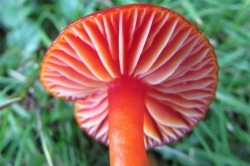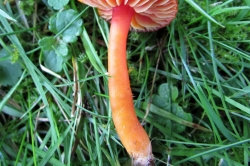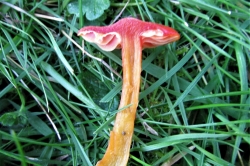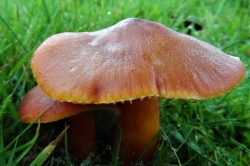The Scarlet Waxcap is one of the smaller red waxcaps, can grow in large numbers in the right conditions and can be more gregarious than other red waxcaps and can be found in several different environments. Being fairly rare though and small this beautiful mushroom, although edible, is better to admire and photograph than to pick for any reason unless found in very large numbers.
Home / Mushroom Guide /
Scarlet Waxcap
Scarlet Waxcap
| Mushroom Type | |
| Common Names | Scarlet Waxcap (EN), Scarlet Hood, Cap Cwyr Coch (CY), Wilgotnica Szkarłatna (PL), Piros Nedűgomba (HU) |
| Scientific Name | Hygrocybe coccinea |
| Season Start | Sep |
| Season End | Dec |
| Average Mushroom height (CM) | 2-7 |
| Average Cap width (CM) | 1-6 |
Cap
1-6 cm. Conical/bell-shaped, can open to convex or flatten with age. Starting deep scarlet but fading to orange/red/yellow.
Gills
Gills starting orange/red becoming yellow to cream with age. Broadly joined to stem (adnate) with a small decurrent tooth. Not crowded.
Stem
2-7 cm long, 0.3-0.8 cm diameter. Scarlet to orange red, yellowing slightly towards the base. Hollow.
Habitat
Fields, meadows, heaths, open woodland, grasslands, lawn and roadsides but they prefer land that has not been fertilised, treated with chemicals or ploughed.
Possible Confusion
The Crimson Waxcap (Hygrocybe punicea), pictured, or the Splendid Waxcap (Hygrocybe splendidissima). The Crimson Waxcap (Hygrocybe punicea) is larger and has a thicker stem and mainly white flesh, the Splendid Waxcap (Hygrocybe splendidissima) has an irregular, wavy, flattened stem.
The Blackening Waxcap (Hygrocybe conica) blackens on cutting or with age.
Spore Print
White to pale yellow. Ellipsoid.
Taste / Smell
Not strong tasting but a colourful addition to any meal if there are a lot about.
Frequency
Fairly common.
Other Facts
Waxcaps are becoming fairly rare due to loss of habitat so they should only be eaten when found in profusion and some mushrooms should always be left behind.



 (39 votes, average: 3.92 out of 5)
(39 votes, average: 3.92 out of 5)
































Leave a Reply